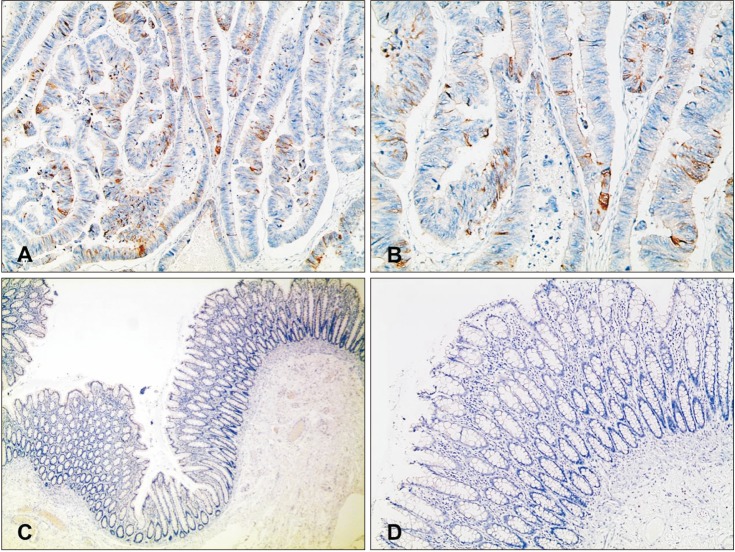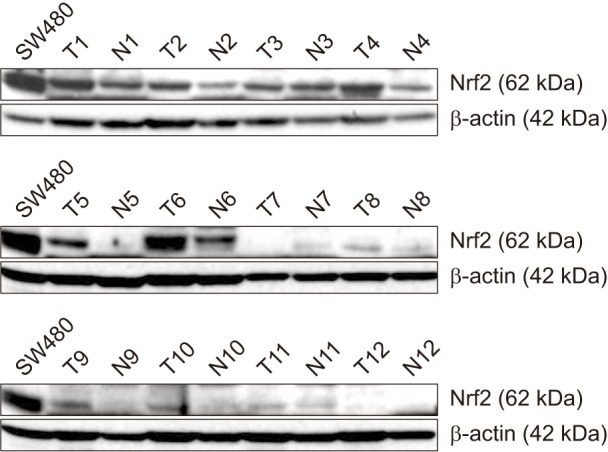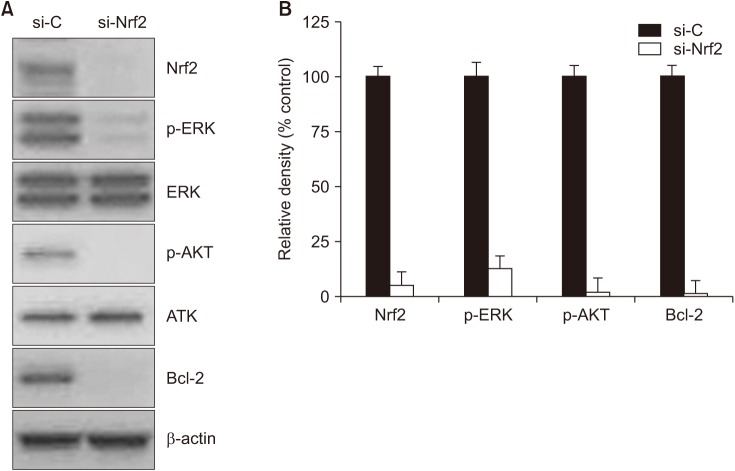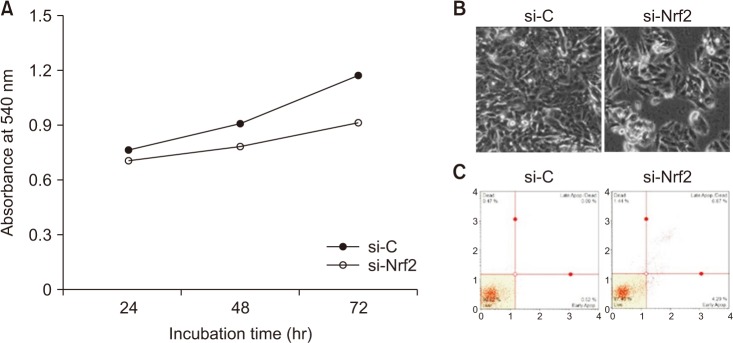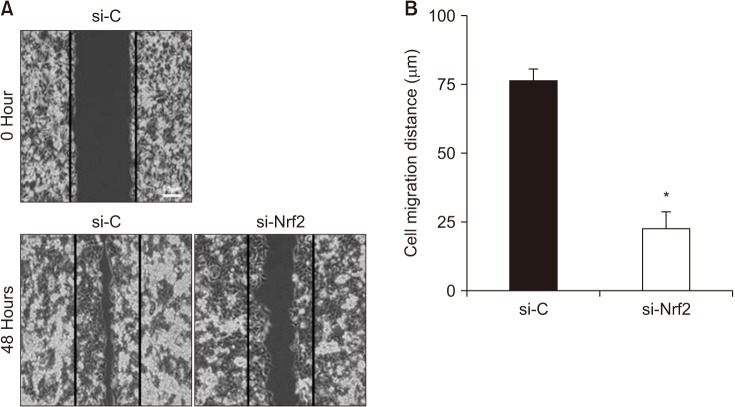Ann Surg Treat Res.
2020 Apr;98(4):159-167. 10.4174/astr.2020.98.4.159.
Overexpression of Nrf2 promotes colon cancer progression via ERK and AKT signaling pathways
- Affiliations
-
- 1Molecular Cancer Research, College of Medicine, Soonchunhyang University, Cheonan, Korea
- 2Department of Surgery, Soonchunhyang University Seoul Hospital, Seoul, Korea
- KMID: 2500814
- DOI: http://doi.org/10.4174/astr.2020.98.4.159
Abstract
- Purpose
We investigated the expression of Nrf2 in colorectal cancer and its correlation with clinicopathological characteristics as well as mechanisms and roles of Nrf2 expression including cell signaling pathway, survival, proliferation, and migration.
Methods
Nrf2 expression was measured in 12 and 30 different colorectal cancer (CRC) tissues by western blot (WB) and immunohistochemistry (IHC), respectively. SW480 cells were used for cell proliferation and cell migration tests. The correlation between the expression of Nrf2 and clinicopathologic parameters were evaluated using the chi-square or Fisher exact test. Data are expressed as the mean ± standard deviation for 3 independent experiments. P < 0.05 was considered statistically significant.
Results
Analysis of WB demonstrated that Nrf2 proteins were increased in CRC tissues, and decreased in normal tissues. IHC staining showed that the Nrf2 expression was elevated in CRC tissues, compared to matched normal tissues. When SW480 cells were suppressed with small interfering RNA of Nrf2, cell viability was inhibited, and cell apoptosis was increased. These results were found along with suppression of the phosphorylated form of extracellular signal-regulated kinase 1/2 and AKT.
Conclusion
This study suggests that overexpression of Nrf2 may be related to carcinogenesis and progression of CRC.
Figure
Reference
-
1. Siegel R, Desantis C, Jemal A. Colorectal cancer statistics, 2014. CA Cancer J Clin. 2014; 64:104–117. PMID: 24639052.
Article2. Gallagher DJ, Kemeny N. Metastatic colorectal cancer: from improved survival to potential cure. Oncology. 2010; 78:237–248. PMID: 20523084.
Article3. Breimer LH. Molecular mechanisms of oxygen radical carcinogenesis and mutagenesis: the role of DNA base damage. Mol Carcinog. 1990; 3:188–197. PMID: 2206282.
Article4. Kobayashi M, Itoh K, Suzuki T, Osanai H, Nishikawa K, Katoh Y, et al. Identification of the interactive interface and phylogenic conservation of the Nrf2-Keap1 system. Genes Cells. 2002; 7:807–820. PMID: 12167159.
Article5. Zhang DD. Mechanistic studies of the Nrf2-Keap1 signaling pathway. Drug Metab Rev. 2006; 38:769–789. PMID: 17145701.
Article6. Kim HR, Kim S, Kim EJ, Park JH, Yang SH, Jeong ET, et al. Suppression of Nrf2-driven heme oxygenase-1 enhances the chemosensitivity of lung cancer A549 cells toward cisplatin. Lung Cancer. 2008; 60:47–56. PMID: 18006113.
Article7. Kim JH, Bogner PN, Ramnath N, Park Y, Yu J, Park YM. Elevated peroxiredoxin 1, but not NF-E2-related factor 2, is an independent prognostic factor for disease recurrence and reduced survival in stage I non-small cell lung cancer. Clin Cancer Res. 2007; 13:3875–3882. PMID: 17606720.
Article8. Ohta T, Iijima K, Miyamoto M, Nakahara I, Tanaka H, Ohtsuji M, et al. Loss of Keap1 function activates Nrf2 and provides advantages for lung cancer cell growth. Cancer Res. 2008; 68:1303–1309. PMID: 18316592.
Article9. Shigematsu H, Lin L, Takahashi T, Nomura M, Suzuki M, Wistuba II, et al. Clinical and biological features associated with epidermal growth factor receptor gene mutations in lung cancers. J Natl Cancer Inst. 2005; 97:339–346. PMID: 15741570.
Article10. Stacy DR, Ely K, Massion PP, Yarbrough WG, Hallahan DE, Sekhar KR, et al. Increased expression of nuclear factor E2 p45-related factor 2 (NRF2) in head and neck squamous cell carcinomas. Head Neck. 2006; 28:813–818. PMID: 16637057.
Article11. Lau A, Villeneuve NF, Sun Z, Wong PK, Zhang DD. Dual roles of Nrf2 in cancer. Pharmacol Res. 2008; 58:262–270. PMID: 18838122.
Article12. Arlt A, Bauer I, Schafmayer C, Tepel J, Muerkoster SS, Brosch M, et al. Increased proteasome subunit protein expression and proteasome activity in colon cancer relate to an enhanced activation of nuclear factor E2-related factor 2 (Nrf2). Oncogene. 2009; 28:3983–3996. PMID: 19734940.
Article13. Hu T, Yao Y, Yu S, Guo H, Han L, Wang W, et al. Clinicopathologic significance of CXCR4 and Nrf2 in colorectal cancer. J Biomed Res. 2013; 27:283–290. PMID: 23885267.
Article14. Li CQ, Kim MY, Godoy LC, Thiantanawat A, Trudel LJ, Wogan GN. Nitric oxide activation of Keap1/Nrf2 signaling in human colon carcinoma cells. Proc Natl Acad Sci U S A. 2009; 106:14547–14551. PMID: 19706542.
Article15. Kim YR, Oh JE, Kim MS, Kang MR, Park SW, Han JY, et al. Oncogenic NRF2 mutations in squamous cell carcinomas of oesophagus and skin. J Pathol. 2010; 220:446–451. PMID: 19967722.
Article16. Motohashi H, Yamamoto M. Nrf2-Keap1 defines a physiologically important stress response mechanism. Trends Mol Med. 2004; 10:549–557. PMID: 15519281.
Article17. Liu D, Zhang Y, Wei Y, Liu G, Liu Y, Gao Q, et al. Activation of AKT pathway by Nrf2/PDGFA feedback loop contributes to HCC progression. Oncotarget. 2016; 7:65389–65402. PMID: 27588483.
Article18. Wang HB, Zhou CJ, Song SZ, Chen P, Xu WH, Liu B, et al. Evaluation of Nrf2 and IGF-1 expression in benign, premalignant and malignant gastric lesions. Pathol Res Pract. 2011; 207:169–173. PMID: 21367536.
Article19. Sadeghi MR, Jeddi F, Soozangar N, Somi MH, Samadi N. The role of Nrf2-Keap1 axis in colorectal cancer, progression, and chemoresistance. Tumour Biol. 2017; 39:1010428317705510. PMID: 28621229.
Article20. Stachel I, Geismann C, Aden K, Deisinger F, Rosenstiel P, Schreiber S, et al. Modulation of nuclear factor E2-related factor-2 (Nrf2) activation by the stress response gene immediate early response-3 (IER3) in colonic epithelial cells: a novel mechanism of cellular adaption to inflammatory stress. J Biol Chem. 2014; 289:1917–1929. PMID: 24311782.21. Sebens S, Bauer I, Geismann C, Grage-Griebenow E, Ehlers S, Kruse ML, et al. Inflammatory macrophages induce Nrf2 transcription factor-dependent proteasome activity in colonic NCM460 cells and thereby confer anti-apoptotic protection. J Biol Chem. 2011; 286:40911–40921. PMID: 21990354.
Article22. Li W, Khor TO, Xu C, Shen G, Jeong WS, Yu S, et al. Activation of Nrf2-antioxidant signaling attenuates NFkappaB-inflammatory response and elicits apoptosis. Biochem Pharmacol. 2008; 76:1485–1489. PMID: 18694732.23. Yokoo Y, Kijima A, Ishii Y, Takasu S, Tsuchiya T, Umemura T. Effects of Nrf2 silencing on oxidative stress-associated intestinal carcinogenesis in mice. Cancer Med. 2016; 5:1228–1238. PMID: 26899729.24. Lee KM, Kang K, Lee SB, Nho CW. Nuclear factor-E2 (Nrf2) is regulated through the differential activation of ERK1/2 and PKC α/βII by Gymnasterkoreayne B. Cancer Lett. 2013; 330:225–232. PMID: 23219897.
Article25. Yuan X, Xu C, Pan Z, Keum YS, Kim JH, Shen G, et al. Butylated hydroxyanisole regulates ARE-mediated gene expression via Nrf2 coupled with ERK and JNK signaling pathway in HepG2 cells. Mol Carcinog. 2006; 45:841–850. PMID: 16739127.
Article26. Niture SK, Jaiswal AK. Nrf2 protein upregulates antiapoptotic protein Bcl-2 and prevents cellular apoptosis. J Biol Chem. 2012; 287:9873–9886. PMID: 22275372.
Article27. Wang J, Zhang M, Zhang L, Cai H, Zhou S, Zhang J, et al. Correlation of Nrf2, HO-1, and MRP3 in gallbladder cancer and their relationships to clinicopathologic features and survival. J Surg Res. 2010; 164:e99–e105. PMID: 20828733.
Article28. Kim WD, Kim YW, Cho IJ, Lee CH, Kim SG. E-cadherin inhibits nuclear accumulation of Nrf2: implications for chemoresistance of cancer cells. J Cell Sci. 2012; 125(Pt 5):1284–1295. PMID: 22302998.
Article29. Shen H, Yang Y, Xia S, Rao B, Zhang J, Wang J. Blockage of Nrf2 suppresses the migration and invasion of esophageal squamous cell carcinoma cells in hypoxic microenvironment. Dis Esophagus. 2014; 27:685–692. PMID: 24028437.
Article30. O'Cathail SM, Wu CH, Lewis A, Holmes C, Hawkins MA, Maughan T. A metagene of NRF2 expression is a prognostic biomarker in all stage colorectal cancer. bioRxiv. 2019; 7. 02. DOI: 10.1101/690974.
- Full Text Links
- Actions
-
Cited
- CITED
-
- Close
- Share
- Similar articles
-
- Regulatory Pathway of Ion-Transporter Genes through Nrf2 Transcription Factor in Hypokalemic Condition
- Dexamethasone Inhibits TGF-β1-Induced Cell Migration by Regulating the ERK and AKT Pathways in Human Colon Cancer Cells Via CYR61
- Phloroglucinol Attenuates Ultraviolet B-Induced 8-Oxoguanine Formation in Human HaCaT Keratinocytes through Akt and ErkMediated Nrf2/Ogg1 Signaling Pathways
- Heregulin-β1 Activates NF-E2-related Factor 2 and Induces Manganese Superoxide Dismutase Expression in Human Breast Cancer Cells via Protein Kinase B and Extracellular Signal-regulated Protein Kinase Signaling Pathways
- LETM1 Promotes Gastric Cancer Cell Proliferation, Migration, and Invasion via the PI3K/Akt Signaling Pathway

